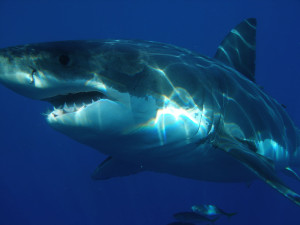
Watson and the Shark
John Singleton Copley, American, 1778
(oil on canvas)
National Gallery of Art, Washington
Shall we take a look at a famous painting of a chilling event in history?
Sometimes art shows real events in history. This famous painting is one of them. It shows an orphan boy named Brook Watson. Brook Watson is the boy in the water. Look carefully. What is happening to him? He is being attacked by a shark! You can see the shark swimming toward Watson as Watson reaches toward a small boat. What other elements of danger are there in the painting? The seawater is forming large waves. There is a hint of red blood in the water. Also, another shark is swimming nearby. You can see the shark’s fin cresting above the waves on the right hand side of the painting. Clearly, the sharks are circling and out for blood. Use your powers of observation. Do you think Watson will survive? Will Watson drown? Will the sharks kill him?
The chilling aspect about this dramatic painting is that it is of a real event. In 1749, Brook Watson was a member of a crew on his uncle’s trading ship, and while swimming alone in Havana harbour, he was attacked by a shark. At the time Watson was only fourteen years old. Make a prediction based on what you see in the painting. What do you think will happen next? According to accounts, the shark in the foreground attacked Watson unprovoked. First it bit off a piece of flesh from his right leg. Then it bit off his foot at the ankle. Thankfully, a small boat was close by and its crew tried to come to his rescue. Describe how the artist has portrayed the crew in the small boat. What are they doing? Two members are leaning over the boat and reaching out to grab hold of Watson. Others are holding onto their mates so they won’t fall overboard. Still others are handling the oars and working to navigate their way toward Watson, while an angry sea jostles their boat around like a mere toy. What about the lad who is standing at the stern (back) of the boat? What is he doing? This brave youth is about to thrust a harpoon into the flesh of the shark and stop the shark from its deadly attack. I will ask you again. Do you think Watson will survive? You will be happy to hear that he does! The crew members fight off the shark and rescue Watson. Are you curious to know what happens to Brook Watson? His right leg is amputated below the knee, but he goes on to live a full life. He even serves a term as Lord Mayor of London, England.
This is the earliest attack by a shark on a person to be fully documented. What do you know about sharks? Sharks range in size from the small dwarf lantern-shark that is less than seven inches in length to the whale shark, which at thirty-nine feet in length is the largest fish in the world! Even though the whale shark is huge, it feeds only on plankton, squid and small fish. Do you know what plankton are? Plankton are drifting organisms, including animals that can’t swim against the current, plants and bacteria. Sharks can be found in every sea. Like other fish, a shark will take in oxygen as seawater passes over its gills. While at rest, most sharks pump water over their gills, but some sharks have lost the ability to do so and must swim without resting in order to breathe. Close your eyes for a moment and imagine a shark. What comes to mind? Do you see a solitary hunter, scourging the seas in search of food? The truth is, many sharks are social and remain in large schools and hunt in packs to herd and capture prey. Even sharks that are loners meet to breed or feed at rich hunting grounds. Perhaps another thing that comes to mind is a shark’s teeth. What if I were to tell you that a shark’s teeth have to be constantly replaced throughout a shark’s life? Would you be surprised to learn that some sharks lose thousands upon thousands of teeth in their lifetime? Perhaps what also comes to mind is the fact that most sharks are carnivorous. While some sharks filter feed plankton, others use camouflage and lie in wait to swallow fish that swim by. Others either swallow small fish whole or take huge bites out of larger fish. Others use their tails to stun their prey. How fast do you think sharks can swim? Sharks can swim on average five miles per hour, but when feeding or attacking, the average shark can reach speeds upwards of twelve miles per hour. One type of shark called the shortfin mako can burst at speeds of up to thirty-one miles per hour! How long do you think sharks live? Most sharks live twenty to thirty years, while the shark called the spiny dogfish can live more than one hundred years!
Perhaps the most popular shark is the great white. Many people are fascinated as well as frightened by the great white shark’s predatory skills. The fact that the great white shark is a large, powerful predator, and sometimes attacks and kills people has led to the belief that all sharks are man-eating monsters. The truth is, out of more than 360 species of shark, only four—the great white, oceanic whitetip, tiger and bull sharks—have been documented to be significantly dangerous to humans. Moreover, sharks, including the great white shark, are more threatened by man than man is threatened by them. How so? Many species of shark are being fished to extinction. Besides over fishing, what other threats does man pose for sharks? Coastal development and pollution have negatively impacted habitats and have reduced the number of prey that sharks depend on to survive.
Let’s return to our painting Watson and the Shark. It was made by the early American artist John Singleton Copley (1738-1815). Copley first made a career painting portraits. When art portrays a real person it is called a portrait. Copley made a career painting portraits of Tories and patriots alike in the American colonies before the American War of Independence (1775-1783). Who were Tories, who were patriots, and what was the American War of Independence? The American War of Independence was the war that the original thirteen American colonies fought when they joined together to break free from the British Empire and its king—King George III—who ruled over them and form a democracy in its place. Tories were American colonists who remained loyal to Great Britain and their king. Patriots were American colonists who rebelled and wanted to break free from the British Empire and its king and form a democracy in its place. Can you name any famous American patriots? Samuel Adams and John Hancock were two famous American patriots. As for Copley, he refused to take sides. Eventually, he fled the American colonies and moved to London to avoid the general unrest before the war and to further his career. It was in London that Brook Watson befriended Copley and asked the artist to paint this important event in his life. The commission allowed Copley to paint the highest subject of art at the time—history painting—and make a name for himself among Europe’s greatest painters.
Let’s take a closer look at the painting. How did Copley use the elements of art to create his composition? First, he contrasted horizontal and diagonal lines to create a sense of depth and perspective. How so? What objects are arranged horizontally? The boy in the water, the shark attacking him, the small boat nearby, and the boats and buildings along the shoreline are all arranged horizontally. What objects are arranged diagonally? The crests of the waves that force the boy toward the shark, the oars of the boat, the thrust of the boy’s arm as he reaches out of the water, and the line of crew members in the boat are all arranged diagonally. Can you see how these horizontal and diagonal lines create a compositional triangle in the immediate foreground (the space up front) and move our eyes in a zigzag fashion into the background? This zigzag pattern from the foreground into the background gives the work depth and perspective and creates energy and action.
Copley certainly picked the right moment in the action to give his scene a sense of impending danger. How so? Everything is happening right before impact: right before the boat hits the shark, right before the shark comes in for the kill, right before the crew member thrusts his harpoon into the shark. Who will get there first? The boat? The shark? The harpoon? We don’t know exactly. What other elements of art create a sense of danger in the work? The quality of the light helps to create a sense of danger. How so? The light is dramatic in that there is a stark contrast between areas of light and areas of shadow. Light flows from the left side of the canvas and highlights the boy, the reaching figures of the crew, and the shark. It also highlights the small boat and creates a tiny triangle of light against the stern that emphasizes the tip of the deadly harpoon. Our eyes naturally end up there. We gasp and wonder what will happen next. Copley heightens the drama even further by having the nearly vertical line of the harpoon pierce right through the horizontally arranged objects, emphasizing the impact of the violence happening before our eyes. It may just be me, but I feel as if I am floundering in the water alongside Watson and watching in horror at the oncoming shark!
§
Copley never visited Havana harbour. He may have studied prints and book illustrations to help him formulate his composition. And he probably never saw a real shark. Perhaps this is why the shark attacking Watson in the painting has anatomical features that are not found in real sharks, such as forward-facing eyes and lips. Even so, Watson and the Shark is well worth seeing in person. Unfortunately, this work is not in the collections at the North Carolina Museum of Art. If you want to see it in person, you can visit the National Gallery of Art in Washington, DC. The original of three versions of Watson and the Shark is at the museum. If you are lucky enough to travel to Washington, perhaps you can arrange a tour for you and your family and friends. It will be well worth your time!



